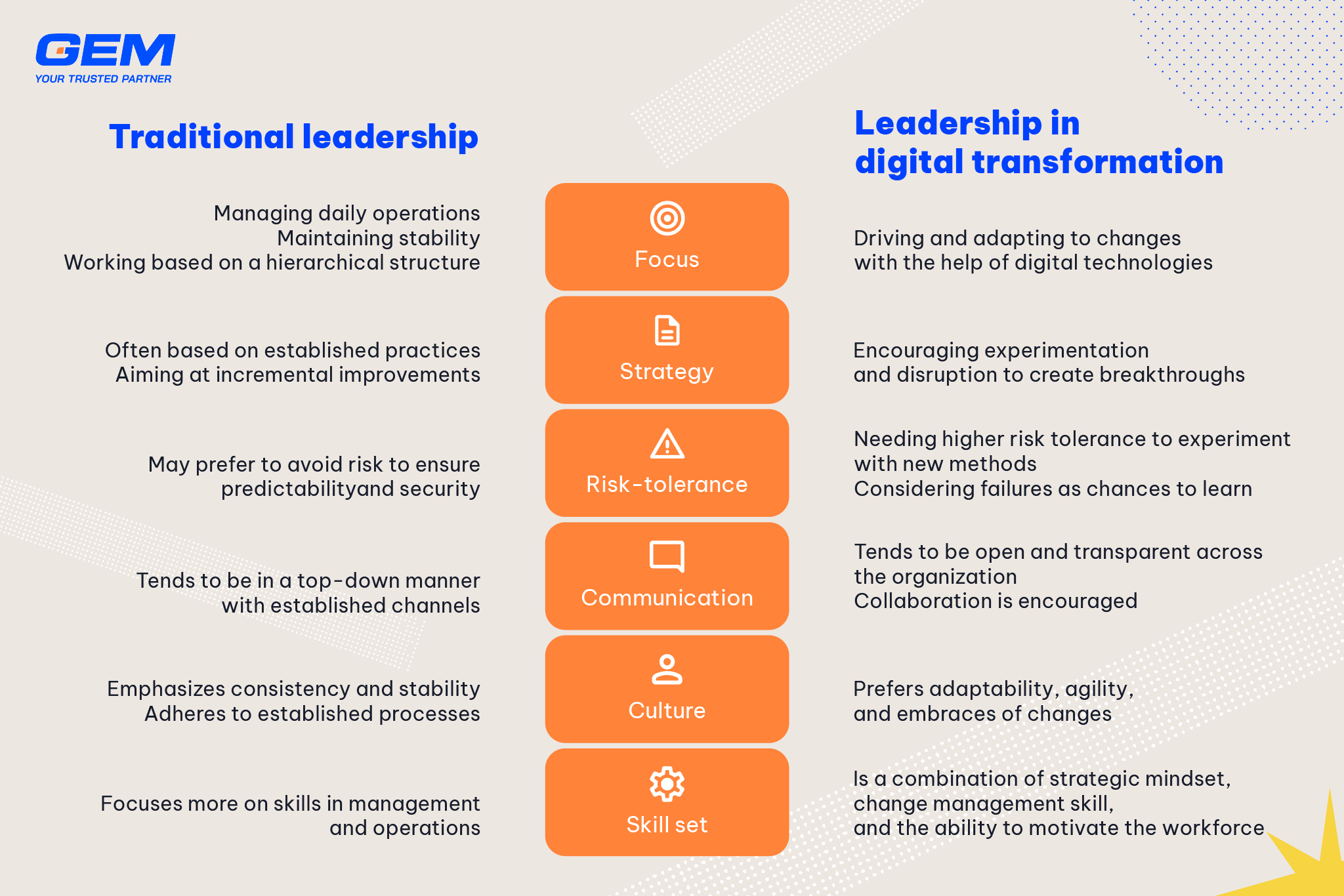Contents
- Introduction
- What is leadership in digital transformation?
- Comparing Traditional leadership vs. Leadership in digital transformation
- Leadership in digital transformation – Four points to keep in mind
- The framework for digital transformation leadership – 6 roles to fulfill
- The must-have traits of digital leaders
- Closing remarks
- Become the digital leader with GEM’s help
Introduction
As businesses around the world begin to undertake digital initiatives to drive efficiency and achieve key business goals, the role of leadership in digital transformation comes into question.
This blog post explores the nuances of leadership in the age of digital transformation. Has anything changed? What does it take for leaders to become the trusted navigator of their organization?

What is leadership in digital transformation?
Leadership in digital transformation is understood as the act of guiding an organization to leverage digital technologies to realize key business goals and objectives.
McKinsey stated that the success of a digital transformation endeavor relies less on digital tools and more on how the organization becomes digital at heart – meaning digitization happens in its mindset, culture, and processes as well. To drive such a comprehensive change, the role of capable digital leaders is undeniable. While it may be unnecessary for leaders to be involved on a daily basis, they play a pivotal role in defining the route of the organization’s digital initiatives and keeping the team grounded.
Comparing Traditional leadership vs. Leadership in digital transformation
Compared to traditional leadership, leadership in digital transformation differs in 6 key aspects: Focus, strategy, risk-tolerance, communication, culture, and skillset. The differences reflect the complexities of the digital transformation era characterized by changes and unpredictability.

Leadership in digital transformation – Four points to keep in mind
There are diverse approaches to executing leadership within a team or an organization. Regardless of the method, managers need to ensure they fulfill four criteria in their practices: effectively managing changes and disruptions, having an adequate strategy to acquire and develop IT talent, maintaining cyber security and data protection, and focusing on the needs and satisfaction of their customers.

Change management
Digital transformation means integrating digital technology into all aspects of a business’s operations. Therefore, it inevitably leads to significant changes in processes and workflows. Without close monitoring, changes can spiral into disruptions and cause negative effects on the organization’s efficiency.
Talent acquisition and development
The growing number and complexity of digital initiatives mean it is more challenging than ever to recruit and retain tech talents. As a result, this aspect of leadership in digital transformation requires greater attention from leaders.

Cyber security and data privacy
While digital technologies provide empowerment and boost efficiency, they also raise concerns about possible cyberattacks and data breaches. As a result, cyber security and data safety are important puzzle pieces of leadership in digital transformation.
Customer centricity
When devising and executing a digital initiative, business leaders must always put their customers and end-users at the center. Everything they do must boil down to customer-focused goals – fulfilling their needs and delivering enhanced experiences and greater values.
The framework for digital transformation leadership – 6 roles to fulfill
According to the 2022 comprehensive research article titled “The Digital Transformation Leadership Framework: Conceptual and Empirical Insights into Leadership Roles in Technology‐Driven Business Environments”, there are six leadership roles representing the ideal managerial behaviors associated with digital transformation. In other words, the six roles below create a holistic framework of what leadership in digital transformation looks like.

The digital pioneer
A digital pioneer is capable of detecting digital trends relevant to the organization’s industry and predicting their impacts. After that, they identify where changes to the status quo are needed and create a strategy accordingly.
The innovator
The innovator turns new ideas into tangible, real-life actions to solve the business problems at hand. He/she also motivates other employees to take part in the process.
The enabler
The enabler provides the support that their team members need by creating an agile and empowering working environment. In such environments, employees are willing to embrace the trial-and-error approach and work in a collaborative and interdisciplinary manner.
The mentor
The mentor is responsible for fostering a supportive and trusting professional relationship with their team members via in-depth guidance and feedback. Leaders who fulfill their mentor role are those who can leverage employees’ individual strengths and weaknesses effectively.
The networker
As the networker, digital leaders regulate interdisciplinary networks and workflows – which can be across and outside the organization. They mediate such complex efforts to ensure any emerging issue is rapidly dealt with and any vital information is known.
The manager
The leader makes sure the team achieves the pre-defined goals and criteria. They monitor and coordinate tasks in a way that the final outcomes are satisfactory in terms of both KPIs and efficiency.
The must-have traits of digital leaders
Another way of conceptualizing leadership in digital transformation is by enlisting its necessary traits. In the digital age, leadership evolves in a new dimension, in which creativity and experimentation are valued. Therefore, to fulfill the role of a digital leader, one must embrace the following characteristics.

Visionary mindset
A digital leader has a clear anticipation of future developments in both the tech and business landscapes. They devise action plans that both are forward-looking and align with the organization’s vision and mission.
Adaptability and innovation
Given the rapid pace of technological advancements, digital leaders must be highly agile and adaptive. They are willing to experiment with new methods, see failure as an opportunity to learn and improve, and encourage their employees to do the same.
Tech understanding
Digital leaders don’t need to be extremely tech-savvy. However, they need a decent understanding of emerging technologies and their connection with key business objectives. This knowledge enables leaders to engage with tech workers and make informed decisions.
Data-driven decision making
The digital age highlights data as its core driver. Therefore, leveraging data analytics to make sensible decisions that drive the organization forward is a must for digital leaders.
Collaborative approach
Digital initiatives are interdisciplinary, so digital leaders are the mediator when different departments collaborate and help them overcome silos and hiccups associated with the integration of new technologies.

Closing remarks
Successful digital transformation is unlikely to happen without effective leadership, which is driven by agility and open-mindedness. To achieve excellent leadership in digital transformation, leaders must transform themselves as well by challenging everything they have known. In return, they can foster purpose, innovation, and engagement in the workplace to best harness the values of digital transformation.
Become the digital leader with GEM’s help
Are you ready to become a digital transformation leader? At GEM Corporation, we have the expertise and proven strategies to guide you through this journey.
With over a decade of experience, numerous real-life success stories, and vảious industry certificates such as ISO27001:2013 and CMMI Maturity Level 3, we are committed to helping you drive innovation and achieve excellence.
Fill out the form below and let’s turn your vision into reality!





